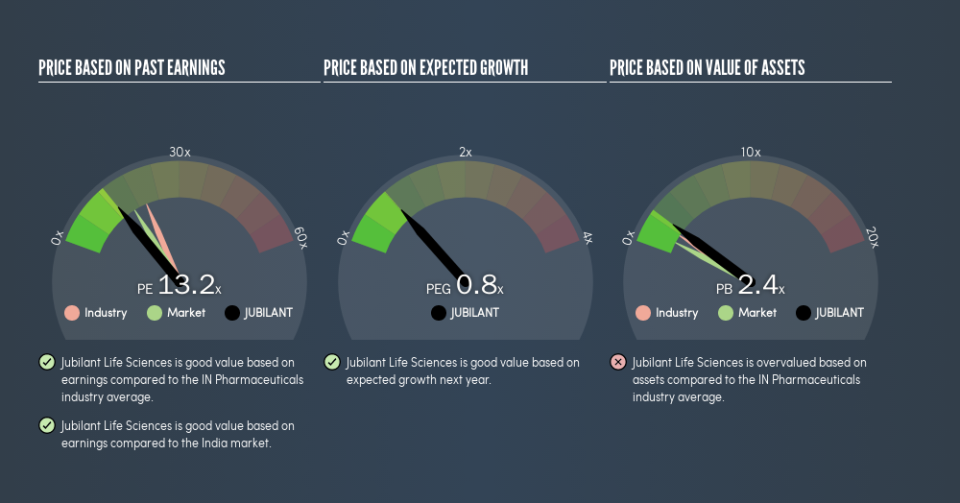Does Jubilant Life Sciences Limited (NSE:JUBILANT) Have A Good P/E Ratio?

Today, we'll introduce the concept of the P/E ratio for those who are learning about investing. We'll look at Jubilant Life Sciences Limited's (NSE:JUBILANT) P/E ratio and reflect on what it tells us about the company's share price. Looking at earnings over the last twelve months, Jubilant Life Sciences has a P/E ratio of 13.2. That is equivalent to an earnings yield of about 7.6%.
See our latest analysis for Jubilant Life Sciences
How Do You Calculate Jubilant Life Sciences's P/E Ratio?
The formula for price to earnings is:
Price to Earnings Ratio = Price per Share ÷ Earnings per Share (EPS)
Or for Jubilant Life Sciences:
P/E of 13.2 = ₹701.8 ÷ ₹53.18 (Based on the trailing twelve months to December 2018.)
Is A High Price-to-Earnings Ratio Good?
A higher P/E ratio means that investors are paying a higher price for each ₹1 of company earnings. That isn't necessarily good or bad, but a high P/E implies relatively high expectations of what a company can achieve in the future.
How Growth Rates Impact P/E Ratios
Probably the most important factor in determining what P/E a company trades on is the earnings growth. Earnings growth means that in the future the 'E' will be higher. That means unless the share price increases, the P/E will reduce in a few years. So while a stock may look expensive based on past earnings, it could be cheap based on future earnings.
Jubilant Life Sciences increased earnings per share by a whopping 30% last year. And its annual EPS growth rate over 3 years is 28%. So we'd generally expect it to have a relatively high P/E ratio.
How Does Jubilant Life Sciences's P/E Ratio Compare To Its Peers?
One good way to get a quick read on what market participants expect of a company is to look at its P/E ratio. The image below shows that Jubilant Life Sciences has a lower P/E than the average (20.2) P/E for companies in the pharmaceuticals industry.
This suggests that market participants think Jubilant Life Sciences will underperform other companies in its industry. While current expectations are low, the stock could be undervalued if the situation is better than the market assumes. If you consider the stock interesting, further research is recommended. For example, I often monitor director buying and selling.
A Limitation: P/E Ratios Ignore Debt and Cash In The Bank
One drawback of using a P/E ratio is that it considers market capitalization, but not the balance sheet. So it won't reflect the advantage of cash, or disadvantage of debt. In theory, a company can lower its future P/E ratio by using cash or debt to invest in growth.
While growth expenditure doesn't always pay off, the point is that it is a good option to have; but one that the P/E ratio ignores.
How Does Jubilant Life Sciences's Debt Impact Its P/E Ratio?
Jubilant Life Sciences has net debt equal to 30% of its market cap. While that's enough to warrant consideration, it doesn't really concern us.
The Verdict On Jubilant Life Sciences's P/E Ratio
Jubilant Life Sciences trades on a P/E ratio of 13.2, which is below the IN market average of 16.3. The company does have a little debt, and EPS growth was good last year. The low P/E ratio suggests current market expectations are muted, implying these levels of growth will not continue. Since analysts are predicting growth will continue, one might expect to see a higher P/E so it may be worth looking closer.
Investors should be looking to buy stocks that the market is wrong about. If the reality for a company is not as bad as the P/E ratio indicates, then the share price should increase as the market realizes this. So this free visualization of the analyst consensus on future earnings could help you make the right decision about whether to buy, sell, or hold.
Of course you might be able to find a better stock than Jubilant Life Sciences. So you may wish to see this free collection of other companies that have grown earnings strongly.
We aim to bring you long-term focused research analysis driven by fundamental data. Note that our analysis may not factor in the latest price-sensitive company announcements or qualitative material.
If you spot an error that warrants correction, please contact the editor at editorial-team@simplywallst.com. This article by Simply Wall St is general in nature. It does not constitute a recommendation to buy or sell any stock, and does not take account of your objectives, or your financial situation. Simply Wall St has no position in the stocks mentioned. Thank you for reading.


